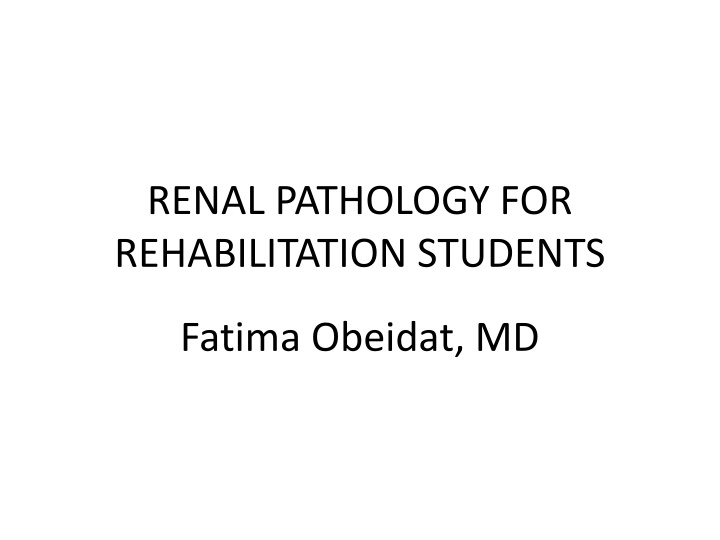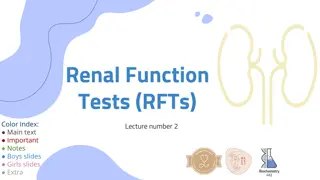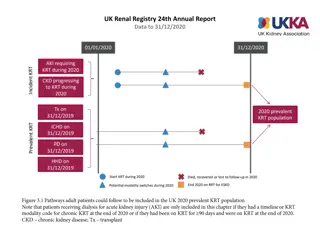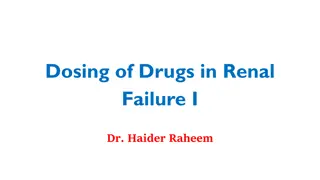
Renal Pathology and Syndromes for Rehabilitation Students
Explore detailed insights into major renal syndromes such as Nephrotic syndrome, characterized by massive proteinuria, hypoalbuminemia, severe edema, hyperlipidemia, and lipiduria. Learn about the causes and primary glomerular lesions associated with this renal condition.
Download Presentation

Please find below an Image/Link to download the presentation.
The content on the website is provided AS IS for your information and personal use only. It may not be sold, licensed, or shared on other websites without obtaining consent from the author. If you encounter any issues during the download, it is possible that the publisher has removed the file from their server.
You are allowed to download the files provided on this website for personal or commercial use, subject to the condition that they are used lawfully. All files are the property of their respective owners.
The content on the website is provided AS IS for your information and personal use only. It may not be sold, licensed, or shared on other websites without obtaining consent from the author.
E N D
Presentation Transcript
RENAL PATHOLOGY FOR REHABILITATION STUDENTS Fatima Obeidat, MD
The major renal syndromes
I. Nephrotic syndrome -Is a glomerular syndrome characterized by: a. Massive proteinuria (excretion of greater than 3.5 g of protein/day in adults), b. Hypoalbuminemia, with plasma albumin levels less than 3 g/dL
c. Severe edema d. Hyperlipidemia, e. Lipiduria (lipid in the urine).
- In all ,there is a derangement in the capillary walls of the glomeruli that results in increased permeability to plasma proteins.
- Long-standing heavy proteinuria, leads to - A. Decreased serum albumin resulting in hypoalbuminemia - B. Drop in plasma colloid osmotic pressure.
- Edema might be exacerbated and may lead to the development of generalized edema (termed anasarca).
- The relative frequencies of the several causes of the nephrotic syndrome vary according to age - In children 1 to 7 years of age: The nephrotic syndrome is almost always caused by a lesion primary to the kidney
- The most important primary glomerular lesions that lead to the nephrotic syndrome are: a. Focal and segmental glomerulosclerosis which is more important in adults b. Minimal-change disease which is is more important in children.
Two other primary lesions, c. Membranous nephropathy d. Membrano-proliferative glomerulonephritis,.
- Among adults it often to renal manifestations of a systemic disease: - The most frequent systemic causes of the nephrotic syndrome in adults are:
a. Diabetes b. Amyloidosis c. Systemic lupus erythematosus
I. Minimal-Change Disease - Is a relatively benign disorder - Is the most frequent cause of the nephrotic syndrome in children.
- Characteristically, A .The glomeruli have a normal appearance by light microscopy but show diffuse effacement of podocyte foot processes when viewed with the electron microscope
-The proteinuria is confined to the smaller plasma proteins, chiefly albumin (selective proteinuria). - The prognosis for children with this disorder is good
II.Focal segmental glomerulosclerosis (FSGS) -Is characterized histologically by sclerosis affecting some but not all glomeruli (focal involvement) and involving only segments of each affected glomerulus (segmental involvement).
Clinical Course Note:. - The incidence of hematuria and hypertension is higher in persons with FSGS than in those with minimal-change disease.
- The FSGS associated proteinuria is nonselective; and - In general the response to corticosteroid therapy is poor.
-At least 50% of patients with FSGS develop end-stage kidney disease within 10 years of diagnosis. - Adults typically fare even less well than children
III. Membranous Nephropathy - Is a slowly progressive disease, - Most common between 30 and 60 years of age. - Histologically, the main feature is diffuse thickening of the capillary wall
Clinical Course - Most cases present as full blown nephrotic syndrome, usually without antecedent illness
- The proteinuria is nonselective, with urinary loss of globulins as well as smaller albumin molecules - Does not usually respond to corticosteroid therapy
- Only about 40% suffer progressive disease terminating in renal failure after 2 to 20 years. - An additional 10% to 30% have a more benign course with partial or complete remission of proteinuria.
The Nephritic Syndrome - Is a clinical complex, usually of acute onset, characterized by (1)hematuria with dysmorphic red cells (2) some degree of oliguria and azotemia (3)hypertension.
-Although proteinuria and even edema also may be present, these usually are not as severe as in the nephrotic syndrome.
- The lesions that cause the nephritic syndrome have in common a. proliferation of the cells within the glomeruli, b. Accompanied by an inflammatory leukocytic infiltrate.
- This inflammatory reaction severely injures the capillary walls, permitting blood to pass into the urine and inducing hemodynamic changes that lead to a reduction in the GFR.
- The reduced GFR is manifested clinically by a. Oliguria, b. Fluid retention
c. Azotemia. d. Hypertension probably is a result of both the fluid retention and some augmented renin release from the ischemic kidneys
-The acute nephritic syndrome may be produced by systemic disorders such as systemic lupus erythematosus, or it may be secondary to primary glomerular disease. - The latter is exemplified by acute postinfectious glomerulo nephritis
Acute Postinfectious (Poststreptococcal) Glomerulonephritis - Acute postinfectious GN, one of the more frequently occurring glomerular disorders
- The classic case of poststreptococcal GN develops in a child 1 to 4 weeks after they recover from a group A streptococcal infection. - Only certain nephritogenic strains of - hemolytic streptococci evoke glomerular disease.
- The main exogenous pattern is seen in poststreptococcal Glomerulonephrits
Clinical Course - The onset of the kidney disease tends to be abrupt, manifested by a. Malaise, b. A slight fever and nausea. c. The nephritic syndrome.
- In the usual case, oliguria, azotemia, and hypertension are only mild to moderate. - Characteristically, there is gross hematuria, the urine appearing smoky brown
-Serum antistreptolysin O antibody titers are elevated in poststreptoco ccal cases. -
- In adults, 15% to 50% of affected persons develop end-stage renal disease over the ensuing few years or 1 to 2 decades, depending on the clinical and histologic severity.
-By contrast, in children, the prevalence of chronicity after sporadic cases of acute postinfectious GN is much lower.
IgA Nephropathy - This condition usually affects children and young adults and begins as an episode of gross hematuria that occurs within 1 or 2 days of a nonspecific upper respiratory tract infection.
-Typically, the hematuria lasts several days and then subsides, only to recur every few months.
- IgAnephropathy is one of the most common causes of recurrent microscopic or gross hematuria - And is the most common glomerular disease revealed by renal biopsy worldwide.
Clinical Course - The disease most often affects children and young adults. - More than half of those with IgAnephropathy present with gross hematuria after an infection of the respiratory or, less commonly, gastrointestinal or urinary tract;
- 5% to 10% develop a typical acute nephritic syndrome. - The hematuria typically lasts for several days and then subsides, only to return every few months
- Many patients maintain normal renal function for decades. - Slow progression to chronic renal failure occurs in 25% to 50% of cases over a period of 20 years.






















